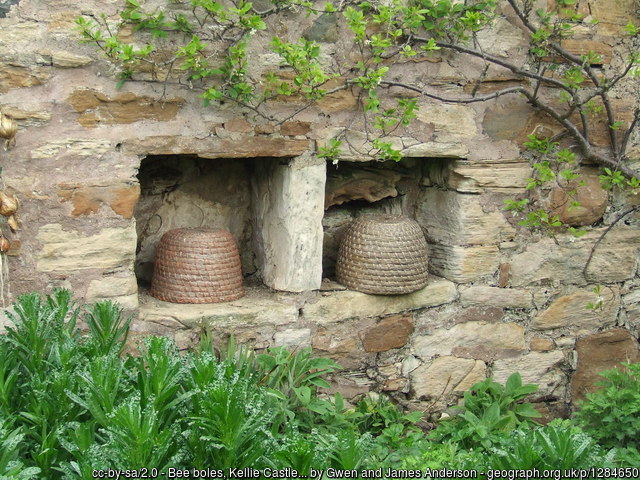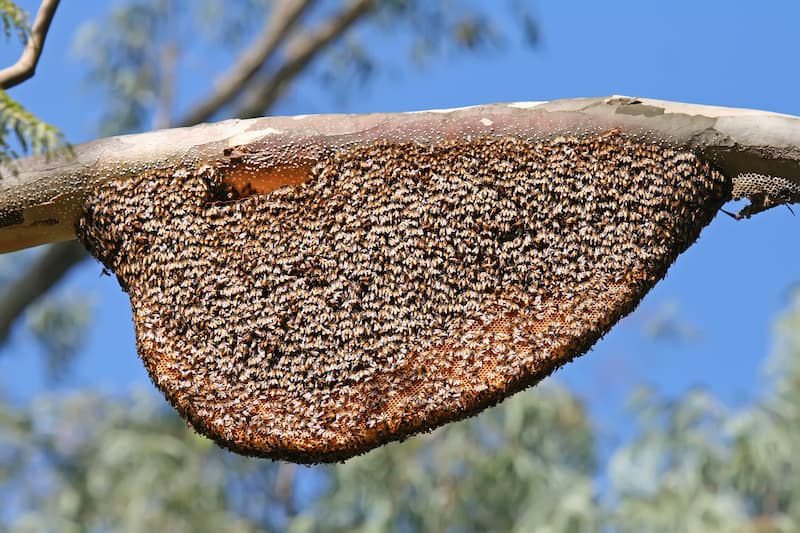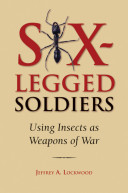Bee bombs
The last couple of posts on overwintering survival and local bees have been heavy going {{1}}. So, rather than more of the same, here’s something that is both informative and entertaining {{2}}.
Though it maybe wasn’t at the time.
Six-legged soldiers
I’m currently enjoying reading Six-legged soldiers by Jeffrey A. Lockwood. This is an account of the many and devious applications man has found for employing insects in warfare. Whilst the topic certainly isn’t ‘laugh out loud’ entertaining, the book is written in an engaging style with plenty of graphic descriptions, ample Biblical and historical references, and enough wriggly, stinging, aggressive insects to make “I’m a celebrity, get me out of here!” {{3}} appear like a walk in the park.
As a beekeeper I’m pleased to see that bees feature significantly in the book.
And as a beekeeper who appreciates the importance of the integrity of the colony to bee survival I also found it a little distressing.
But as a source of all sorts of stories for friends and families over the forthcoming holiday season it probably cannot be beaten.
It’s pretty good on mosquitos as well …
Bombus away
The genus Bombus includes lots of the well known bumble bees e.g. Bombus terrestris (Buff tailed), B. pascuorum (Common carder) and B. hypnorum (Tree) . The generic name Bombus is derived etymologically from the Latin word bombus which means buzzing i.e. the noise a bee makes when it flies.
Etymologically, the word bomb, has a similar origin – via bombe in French, bomba in Spanish, bombo and then the Latin bombus.
Boom also has a similar origin.
But that’s not the only link between bees and bombs.
Mushroom shaped clouds
Have you ever seen anyone drop a full brood box?
It is an amazing sight and one best appreciated from a distance and when wearing a full beesuit.
Bees do not appreciate being knocked, shocked or jarred. When I transport hives between apiaries I always give them several minutes to settle before removing the entrance block. If you don’t they tend to boil out the front spoiling for a fight.
So you can imagine that dropping a brood box from waist height achieves – simultaneously – the sudden jarring of the colony and the release of the bees.
Not so much ‘shock and awe‘ as shock and aargh!
The mushroom-shaped cloud of bees that are released are distinctly agitated.
In the absence of a beesuit you’re likely to get hammered.
Even with a beesuit there can be some uncomfortable moments.
And, since soldiers don’t routinely go into battle wearing camouflage BBwear battledress with an inbuilt fencing-style veil, this neatly brings us to using bees as weapons.
Package bees
These days a ‘package’ is one way to buy bees to start a colony.
But as a weapon, a colony of bees isn’t much use until it’s actually in something.
How do you carry them? How do you use them as a projectile?
Well, man is nothing if not ingenious when it comes to weapons development.
The Tiv people of Nigeria used a specially shaped horn, loaded with angry bees (presumably not so much Africanized as African ? ). In the heat of battle these would be fired at the opposition, with the horn-shape ensuring the bees both reached the enemy and were kept at a distance from friendly forces {{4}}.
But then, 9000 years ago, pottery containers started to be used for beekeeping … and it got a whole lot easier to move the bee bombs to the front line and drop them on the opposition.
A big, beautiful wall
A wall seems like an obvious way to defend yourself.
The enemy have to knock the wall down, or go over or under the wall.
And if they choose to tunnel under the wall then they’re going to be less than enthusiastic if the tunnel is filled with bees.
Which is what happened in 908 when the Scandinavians laid siege to Chester. The city’s fortifications were impenetrable, so they tunnelled underneath them. The siege was ended when all the city’s beehives were dumped into the tunnel.
The Scandinavians appear not to have learnt their lesson as they were again repelled by bees while storming the walled city of Kissingen (Germany) during the Thirty Years War (1618-48). In this instance the bees were dropped from a height onto the Swedish forces.
The troops were heavily armed and armoured, and were unfazed.
Their horses were not.
The siege collapsed as the cavalry mounts were driven into a frenzy by the bees. Even now, most beekeepers are aware that bees and horses don’t mix well.
Again in the 1600’s, the besieged nuns of Wuppertal (Germany) knocked over all the hives in their apiaries before – wisely – hiding indoors. The maelstrom of bees drove the marauding soldiers away and the town was subsequently renamed Beyenberg (‘bee town’).
Bee boles
A bee bole is a recess in a wall {{5}} designed to house a hive of bees, which – in the days when they were constructed – was likely a skep. Many castles and fortified town walls have bee boles built into them.
How convenient.
What could be easier than to drop these on the marauding troops trying to scale the ramparts or storm the drawbridge?
As an aside, IBRA (The International Bee Research Association) maintain the comprehensive Bee Boles Register which is well worth searching if you are interested in historical beekeeping (or early bomb design).
Avoiding friendly fire
You’ll notice that a lot of these bees were being used in relatively close combat situations.
Having witnessed a brood box being dropped, I can assure you that bees are rather indiscriminate after a “dropped from a great height onto a hard surface” experience.
Far better to use the container housing the bees as a projectile, launching them at the opposition from a safe distance.
Safe in terms of contact with the enemy … and the bees ?
The Greeks and subsequently the Romans developed and perfected the siege engine, capable of launching all sorts of things up and over defensive walls.
Including beehives.

Illustration of a ballista being loaded and drawn – note BBwear ‘Corinthian helmet’ style beesuit and veil.
The Greek ballista and the Roman onager were torsion powered siege engines developed between 400 BC and 350 AD. Both were capable of firing stones, often wrapped in combustible material set alight, with smaller later models also used as battlefield weapons firing projectiles 500 – 1000 yards.
They’d have barely broken a sweat firing one or more skeps at the enemy.
The Romans were so keen on bee bombs that there was a documented decline in hive numbers during the late Roman Empire.
And this enthusiasm continued … as did the demand for hives to hurl.
By the 14th Century those dastardly weapons designers had developed a windmill-like device capable of launching hive after hive from the end of its rapidly rotating arms.
Bees will not fly over water
But they will in a skep catapulted from a ship.
As the army developed entomological weaponry the navy exploited it.
As early as 330 BC pottery hives were being thrown at enemy ships during naval battles. Cannons and cannonballs eventually superseded 20,000 A. mellifera ligustica in a skep, but there is well-documented use of bees in naval warfare until at least the 1600’s.
Bees would therefore have been carried by warships for hundreds of years. It’s not documented how the colonies were managed or maintained. Perhaps they only fought local battles? However, since that rather defeats the purpose of a highly mobile navy it can be assumed that bees were probably transported long distances by sea … bringing a whole new meaning to the term migratory beekeeping.
Gunpowder and bees
Eventually the development of modern weaponry overtook the use of bees and beehives. Fortunately we don’t have to discuss the aerodynamic benefits of cedar vs. poly hives {{6}}.
Gunpowder and explosives made the Gatling gun-like skep-launching windmill catapult a relic of the good old days of warfare, when the infantry hankered after really cold days when the bees would be torpid and much less aggressive.
But, as a couple of masochists have already demonstrated, Apis mellifera is pretty tame where stinging is concerned.
Apis dorsata, the giant honey bee of South East Asia, is much bigger than our honey bee, and is reputed to pack more of a punch when stinging {{7}}.
These bees build large exposed nests and the colony may have up to 100,000 bees in it.
Which doesn’t mix too well with gunpowder or, more specifically, a firecracker containing gunpowder.
During the Vietnam War the Viet Cong would attach firecrackers to dorsata nests relocated to the jungle trails used by the enemy. As a patrol passed by they would ‘light the blue touch paper’ and set off the firecracker.
And then stand well back.
And, at about the same time (1960’s), the Americans were developing chemical warfare approaches using isopentyl acetate, the alarm pheromone, with the intention of spraying it onto enemy troops and redirecting the bees to attack them instead.
There’s lots more in Six-Legged Soldiers … get a copy and enjoy reading it over the Christmas vacation. Jeffrey Lockwood is an entomologist and University of Wyoming Professor. The Sunday Times 2009 review of the book criticised it as ‘scarcely scholarly’, being a mix of myth, legend and historical facts.
I cannot imagine a better review and it probably explains why it is so entertaining to read ?
Mite bombs
These are something altogether different to bee bombs … and for regular beekeepers, much more relevant.
A mite bomb is a heavily mite infested and collapsing colony that liberally spreads Varroa mites around the neighbourhood. Recent evidence suggests that this occurs primarily during late-season robbing of weak (mite infested) colonies by strong colonies.
This is the primary reason late summer miticide treatment should be coordinated over a wide geographic area. What’s the point of treating your strong colonies if they’re going to load up on mites when robbing weak colonies in the adjacent fields?
Which reminds me, and should remind you, that winter mite treatments will be needed in the next few weeks to ensure your bees get the best possible start to the new season.
We’ve had a protracted cold period here in Fife and my colonies will probably be treated in the next 5-7 days before there’s a chance they start brood rearing again.
{{1}}: Well read though … or at least lots of people started reading. Looking at the access statistics doesn’t tell me how many gave up half way through.
{{2}}: I hope.
{{3}}: A British survival reality television game show, aired live on ITV from Australia. The format sees a group of celebrities living together within an Australian jungle camp, coping with few creature comforts. And witchetty grubs. This is what is termed ‘light entertainment’. It isn’t.
{{4}}: But imagine the grief involved in loading the horn with stroppy bees.
{{5}}: Bole in Scots means exactly that, a recess in a wall.
{{6}}: Though perhaps warfare would be less terrible if we did.
{{7}}: Although Justin Schmidt in his famous Schmidt Sting Pain index, still only ranked it a 2 out of 4, along with A. mellifera and the common wasp. And he should know.





Join the discussion ...